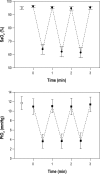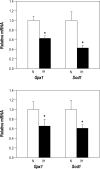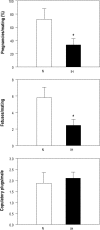Male fertility is reduced by chronic intermittent hypoxia mimicking sleep apnea in mice
- PMID: 25364071
- PMCID: PMC4196059
- DOI: 10.5665/sleep.4166
Male fertility is reduced by chronic intermittent hypoxia mimicking sleep apnea in mice
Abstract
Study objectives: Obstructive sleep apnea (OSA) is characterized by intermittent hypoxia and oxidative stress. However, it is unknown whether intermittent hypoxia mimicking OSA modifies male fertility. We tested the hypothesis that male fertility is reduced by chronic intermittent hypoxia mimicking OSA in a mouse model.
Design: Case-control comparison in a murine model.
Setting: University research laboratory.
Participants: Eighteen F1 (C57BL/6xCBA) male mice.
Interventions: Mice were subjected to a pattern of periodic hypoxia (20 sec at 5% O2 followed by 40 sec of room air) 6 h/day for 60 days or normoxia. After this period, mice performed a mating trial to determine effective fertility by assessing the number of pregnant females and fetuses.
Measurements and results: After euthanasia, oxidative stress in testes was assessed by measuring the expression of glutathione peroxidase 1 (Gpx1) and superoxide dismutase-1 (Sod1) by reverse-transcription polymerase chain reaction. Sperm motility was determined by Integrated Semen Analysis System (ISAS). Intermittent hypoxia significantly increased testicular oxidative stress, showing a reduction in the expression of Gpx1 and Sod1 by 38.9% and 34.4%, respectively, as compared with normoxia (P < 0.05). Progressive sperm motility was significantly reduced from 27.0 ± 6.4% in normoxia to 12.8 ± 1.8% in the intermittent hypoxia group (P = 0.04). The proportion of pregnant females and number of fetuses per mating was significantly lower in the intermittent hypoxia group (0.33 ± 0.10 and 2.45 ± 0.73, respectively) than in normoxic controls (0.72 ± 0.16 and 5.80 ± 1.24, respectively).
Conclusions: These results suggest that the intermittent hypoxia associated with obstructive sleep apnea (OSA) could induce fertility reduction in male patients with this sleep breathing disorder.
Keywords: hypoxia; male fertility; obstructive sleep apnea; oxidative stress.
Figures




Comment in
-
Sleep apnea as a potential threat to reproduction.Sleep. 2014 Nov 1;37(11):1731-2. doi: 10.5665/sleep.4158. Sleep. 2014. PMID: 25364067 Free PMC article. No abstract available.
Similar articles
-
Normoxic Recovery Mimicking Treatment of Sleep Apnea Does Not Reverse Intermittent Hypoxia-Induced Bacterial Dysbiosis and Low-Grade Endotoxemia in Mice.Sleep. 2016 Oct 1;39(10):1891-1897. doi: 10.5665/sleep.6176. Sleep. 2016. PMID: 27397563 Free PMC article.
-
Atorvastatin attenuates intermittent hypoxia-induced myocardial oxidative stress in a mouse obstructive sleep apnea model.Aging (Albany NY). 2021 Jul 21;13(14):18870-18878. doi: 10.18632/aging.203339. Epub 2021 Jul 21. Aging (Albany NY). 2021. PMID: 34289453 Free PMC article.
-
Intermittent hypoxia in utero damages postnatal growth and cardiovascular function in rats.J Appl Physiol (1985). 2018 Apr 1;124(4):821-830. doi: 10.1152/japplphysiol.01066.2016. Epub 2017 Dec 14. J Appl Physiol (1985). 2018. PMID: 29357521
-
Intermittent Hypoxia as a Model of Obstructive Sleep Apnea: Present and Future.Sleep Med Clin. 2025 Mar;20(1):93-102. doi: 10.1016/j.jsmc.2024.10.009. Epub 2024 Nov 16. Sleep Med Clin. 2025. PMID: 39894602 Review.
-
Intermittent hypoxia and vascular function: implications for obstructive sleep apnoea.Exp Physiol. 2007 Jan;92(1):51-65. doi: 10.1113/expphysiol.2006.035204. Epub 2006 Nov 23. Exp Physiol. 2007. PMID: 17124276 Review.
Cited by
-
Obstructive sleep apnea increases risk of female infertility: A 14-year nationwide population-based study.PLoS One. 2021 Dec 15;16(12):e0260842. doi: 10.1371/journal.pone.0260842. eCollection 2021. PLoS One. 2021. PMID: 34910749 Free PMC article.
-
COVID-19 and male reproductive system: pathogenic features and possible mechanisms.J Mol Histol. 2021 Oct;52(5):869-878. doi: 10.1007/s10735-021-10003-3. Epub 2021 Jul 7. J Mol Histol. 2021. PMID: 34232425 Free PMC article. Review.
-
Does increased serum d-lactate mean subclinical hyperpermeability of intestinal barrier in middle-aged nonobese males with OSA?Medicine (Baltimore). 2017 Dec;96(49):e9144. doi: 10.1097/MD.0000000000009144. Medicine (Baltimore). 2017. PMID: 29245360 Free PMC article.
-
Hypoxia exposure impairs male fertility via inhibiting Septin2-mediated spermatogonial proliferation.Hum Reprod Open. 2025 May 14;2025(3):hoaf027. doi: 10.1093/hropen/hoaf027. eCollection 2025. Hum Reprod Open. 2025. PMID: 40487848 Free PMC article.
-
Experimental Models to Study End-Organ Morbidity in Sleep Apnea: Lessons Learned and Future Directions.Int J Mol Sci. 2022 Nov 20;23(22):14430. doi: 10.3390/ijms232214430. Int J Mol Sci. 2022. PMID: 36430904 Free PMC article. Review.
References
-
- Tufik S, Santos-Silva R, Taddei JA, Bittencourt LRA. Obstructive sleep apnea syndrome in the Sao Paulo Epidemiologic Sleep Study. Sleep Med. 2010;11:441–6. - PubMed
-
- Almendros I, Farré R, Torres M, et al. Early and mid-term effects of obstructive apneas in myocardial injury and inflammation. Sleep Med. 2011;12:1037–40. - PubMed
-
- Martínez-García MA, Capote F, Campos-Rodríguez F, et al. Spanish Sleep Network. Effect of CPAP on blood pressure in patients with obstructive sleep apnea and resistant hypertension: the HIPARCO randomized clinical trial. JAMA. 2013;310:2407–15. - PubMed
-
- Trzepizur W, Le Vaillant M, Meslier N, et al. Independent association between nocturnal intermittent hypoxemia and metabolic dyslipidemia. Chest. 2013;143:1584–9. - PubMed
Publication types
MeSH terms
Substances
LinkOut - more resources
Full Text Sources
Other Literature Sources
Medical
Miscellaneous

